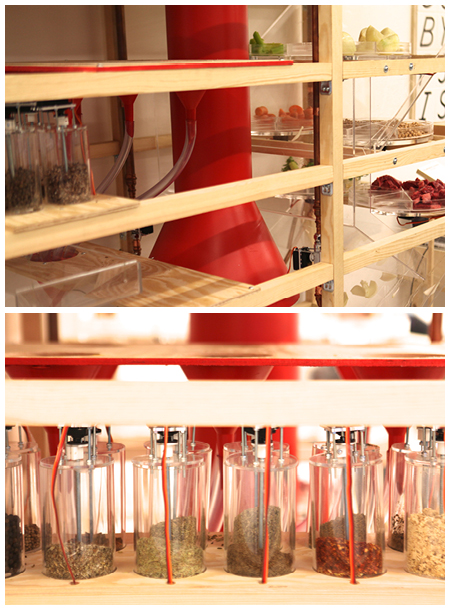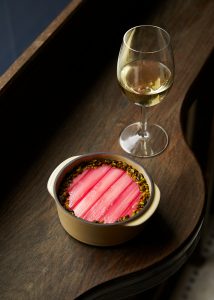Alex Moore talks to Pjadad/Isberg, the duo behind a unique technological cooking experiment that traverses international borders
Ambling through Clerkenwell yesterday, tiled, lamped, and thoroughly chaired-out, I caught a whiff of a rich vegetable stock coming from somewhere down Great Sutton Street. Following my nose, I arrived at Strange Beast & Co.’s temporary gallery space, where, emitting the delicious smell was the most outlandish design I’d seen all day. The ‘Collaborative Cooking’ machine is a large shelving unit containing 35 cooking functions/ingredients (meats, veg, herbs and spices), stored in unique dispensers that can all be added remotely to a large pot at the bottom of the contraption and cooked à la Wallace and Gromit. When I entered the gallery, the machine was halfway through cooking a stew, and was being controlled by two chefs in Sweden.
The two designers behind this wonderful machine Pjadad/Isberg, Petter Johansson and Christian Isberg, tell me they try to “always work from a perspective where content is the important part rather than the aesthetics” – a gospel according to very few graphic designers. This may be why curator Sam O’Keefe put them on kitchen duty while designating rooms to design in the ‘Strange Beast House’, the pair had been brewing this idea for a while.

“It makes you think who actually makes the food? It’s the same discussion as Marcel Duchamp’s ‘readymades'”
Originating from an initial idea of a remote control toaster – anything for an extra minute in bed – long before the interactive kitchen was being formulated, it begs the question: does cooking require a physical presence or is it possible to create and explore through digital platforms and experience food beyond the known limitations? “We asked a pretty famous chef in Sweden called Stefan Eriksson,” says Petter, “‘Do you need to taste your food while you’re cooking?’ He said, ‘Not as long as I have cooked it.’ Then we started thinking more physical, how do we produce something like this?”
After a year of planning with programmer Lasse Korsgaard and chef Carl Berglöf, the machine was quick in the making. ‘If you sat down and counted the hours, all the drawings are done in one day, in 8 hours. But I think that’s the result of all the talk, it was just there so it was quite fast to execute it. It was a little bit like we built a grid that we could actually experiment in – the grid is the structure.’
“We asked a pretty famous chef in Sweden called Stefan Eriksson, ‘Do you need to taste your food while you’re cooking?’ He said, ‘Not as long as I have cooked it.'”
With the impetus on content over aesthetic, the food has got got to be good. “We asked the chef, ‘How can we make a recipe with endless possibilities for a result?’ He thought about it for a long time, and 35 ingredients are a recipe that together can make millions of flavours and situations.”
Suddenly there’s a whirring, and the machine springs to life. A carefully measured portion of beef comes out of its wheel and slides down a ramp into the pot. Is this machine designed to replace the chef we know? “Everyone wants to go to these fancy new restaurants and everyone wants to eat food composed or cooked by a master-chef. But the way I see it, the master-chef curates the whole food, it’s a big façade. You go to a restaurant run by this chef but how is he involved in the actual food that is being served? Putting up the menu? Shopping for onions? Finding the beef? And does it matter who actually does it? With this machine you could ask any chef to prepare the machine and he could invite some chefs who would actually execute it and cook it. It makes you think who actually makes the food? It’s the same discussion as Marcel Duchamp’s ‘readymades’. I think from the chef’s perspective, if the chef runs a restaurant they want to take responsibility for it.”
The machine works as a unique collaborative experiment between professional chefs, anonymous participants and the creators of the framework, with an aim to create abstract dialogues about cooking. It is also a fascinating piece of design and the pair are keen to test its commercial viability, with a pop-up restaurant in Stockholm next month, this time with five remotely operating chefs who would chair a discussion after the meal.
“When we spoke to the chef yesterday and he said in the beginning he though it was just fun, but then in the end he was really worried… He’s called me a few times and asked me to go and taste it, and I said ‘No way, that’s never going to happen.'” He paused, smiling. “That would destroy the whole experiment.”




